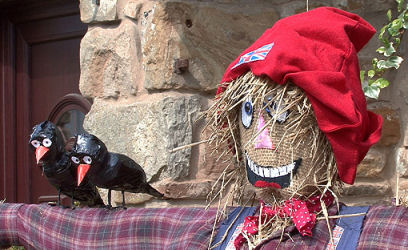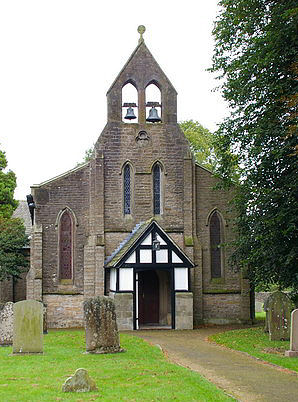Wray
OS Grid ref:- SD616699
 The small village of Wray is situated in the attractive Lune Valley, a mile from Hornby and 10 miles to the north east of Lancaster and lies at a point at which the River Roeburn joins the River Hindburn.
The small village of Wray is situated in the attractive Lune Valley, a mile from Hornby and 10 miles to the north east of Lancaster and lies at a point at which the River Roeburn joins the River Hindburn.
 Wray is famous for its Scarecrow Festival,which attracts tens of thousands of visitors each year. The Scarecrow Festival was established in 1995 and takes place every year during the week leading up to May Day when there is a fair. During the week there are refreshments served daily in the village hall and a parade of the giants. Lots of the villagers put up elaborate and often topical scarecrows outside their homes.
Wray is famous for its Scarecrow Festival,which attracts tens of thousands of visitors each year. The Scarecrow Festival was established in 1995 and takes place every year during the week leading up to May Day when there is a fair. During the week there are refreshments served daily in the village hall and a parade of the giants. Lots of the villagers put up elaborate and often topical scarecrows outside their homes.
The village has a general store with a post office and also also has a pub, The George and Dragon; a tearoom, Bridge House Farm Tearooms; and a restaurant, Bridge House Bistro. A number of old stone buildings with flagged roofs (a local style) survive in Wray dating from the seventeenth and eighteenth centuries, these can be identified by the datestones set into their frontages. Wray school was built with funds donated by Captain Richard Pooley in 1684. Captain Pooley fought for the Roundheads during the civil war.
In the nineteenth century, Wray was a centre of hat, nail and bobbin production. The village is surrounded by the superb scenery of the Lune Valley and there are many pleasant walks in the area around Wray including the banks of the River Roeburn.
A flash flood of incredible speed and ferocity which occured at about 4 o'clock in the afternoon of 8 August 1967, when an estimated 4.6 inches of rain fell on the Bowland Fells in 90 minutes, the pretty babbling River Roeburn at its confluence with the Hindburn turned into a raging torrent, the river burst its banks resulting in the loss of houses, bridges, livestock, vehicles, and personal possessions. The river was said to have risen some 20 feet in 20 minutes, the flood destroyed seven bridges built on historic arches and Backsbottom Farm which had stood close to the river since 1777. Despite the scale of the devastation, no serious injury was done to any residents. A local temperance preacher blamed the floods on the wrath of the Almighty because Wray had 2 public houses!
The flood is illustrated in the handsome Millennium Mosaic, A community project to mark the turn of the millennium, the mosaic was completed in September 2000, it represents the wind and storm spewing out a great tide of water. The mosaic is in the 'Flood Garden' on Main Street, the site of a riverside terrace of cottages which were demolished by the flood.

 The semi circular cobblestone mosaic is comprised of black pebbles from a Cumbrian seashore, white pebbles from Wales, and carved insets made from green Elterwater slate. The brown stones representing the main flood water were gathered by villagers from the bed of the Roeburn and Hindburn. Maggy Howarth, of nearby Wennington, whose cobblestone mosaics are nationally known, designed the mosaic.
The semi circular cobblestone mosaic is comprised of black pebbles from a Cumbrian seashore, white pebbles from Wales, and carved insets made from green Elterwater slate. The brown stones representing the main flood water were gathered by villagers from the bed of the Roeburn and Hindburn. Maggy Howarth, of nearby Wennington, whose cobblestone mosaics are nationally known, designed the mosaic.
The village church of Holy Trinity (pictured left) was constructed in 1839–40 and designed by the Lancaster architect Edmund Sharpe, at a cost of £2,021 (£150,000 as of 2013). The foundation stone was laid on 28 May 1839, and the church was completed the following year, although it was not consecrated until 1 July 1841, when the Bishop of Chester performed the ceremony.
In 1879–80 the church was enlarged by Sharpe's successors, Paley and Austin, who rebuilt the chancel, reseated the church, and added an organ chamber and a porch at a cost of £1,307. In 1889 the same practice, now Austin, Paley and Austin, added a new nave roof, and altered the west elevation.
Holy Trinity has a three-bay nave, each bay containing a triple lancet window. At the west end are four lancets, one on each side and two over the entrance. The chancel, added by Paley and Austin, has two bays and a three-light east window containing Decorated tracery. At the west end of the church is a double bellcote. Inside the church is a west gallery, containing the organ. The two-manual organ was made in 1879 by Gray and Davison and overhauled in 1980 by R. D. and E. H. Holmes.
Nearby places of interest
Hornby Castle- once painted by Turner, is an imposing Gothic structure which dominates the landscape from its commanding
position above the River Wenning.
Lancaster Castle founded in the tenth century
Ashton Memorial in Williamson Park, Lancaster was commissioned by James Williamson, Baron Ashton as a tribute to his second wife, Jenny and was built between 1907 and 1909.
Flood walk from Wray
Distance - 0.6 miles
*From Bridge House Farm Tearooms in Wray, turn right. Cross the bridge and continue up the main street. Turn left after passing the village shop and continue to the school.
*Take the footpath to the left which leads along the side of the school. This route is known as The Spout leads through to Kitten Bridge over the River Roeburn.
*Cross over this bridge and up to the road and turn left to follow the road back to Bridge House Farm Tearooms.
